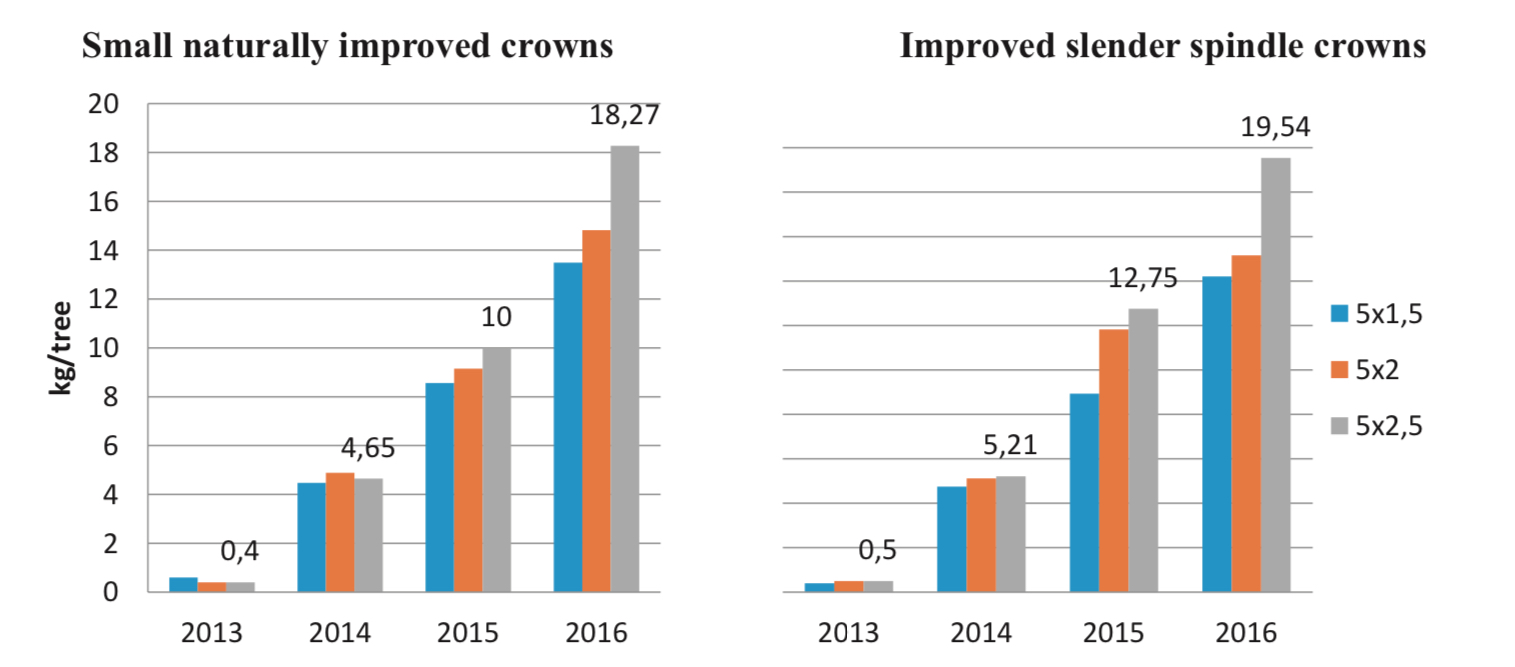In sweet cherry orchards, multiple factors influence productivity and fruit quality. A study conducted between 2010 and 2022 in Moldova evaluated how different cultivation systems affect the production efficiency and fruit quality in sweet cherry, focusing on the interaction between variety-rootstock combinations, canopy training systems, and planting distances.
The varieties studied included “Valerii Cikalov”, “Record”, “Ferrovia”, “Kordia”, “Regina”, “Stella”, “Skeena”, “Bigarreau Burlat”, and “Lapins”. These were grafted onto Cerasus mahaleb L., “Gisela 6”, and “MaxMa 14” rootstocks in various combinations and cultivated with different planting distances.
Rootstocks and productivity
The results showed that trees grafted onto Cerasus mahaleb L. rootstocks exhibited more vigorous growth and reached average yields between 15.58 and 16.12 t/ha during full productivity. In contrast, trees on “Gisela 6” and “MaxMa 14” rootstocks entered production earlier but yielded slightly less, with averages between 12.50 and 14.58 t/ha.
The choice of planting distance and canopy shape proved crucial to maximizing yield and improving fruit quality. During the first two fruiting years, yield per tree was not influenced by in-row spacing, but from the third year onward, larger spacing between trees led to higher per-tree yields.
For instance, in 2015, the “Bigarreau Burlat” variety planted at 5 x 1.5 m yielded 6.93–8.56 kg/tree, while those planted at 5 x 2.5 m yielded 10.0–12.75 kg/tree. By the seventh year, these differences were even more pronounced.
 Figure 1. The yield of the sweet cherry trees of the Bigarreau Burlat variety depending on the planting distance and the crown shape, kg/tree (Gisela 6 rootstock, the age of the trees – 4-7 years old, Terra-Vitis Ltd).
Figure 1. The yield of the sweet cherry trees of the Bigarreau Burlat variety depending on the planting distance and the crown shape, kg/tree (Gisela 6 rootstock, the age of the trees – 4-7 years old, Terra-Vitis Ltd).
High-density planting
However, yield per hectare was greater in high-density layouts. Specifically, the “Bigarreau Burlat”, “Ferrovia”, and “Lapins” varieties planted at 5 x 1.5 m achieved the highest yields, ranging from 17.98 to 20.07 t/ha, exceeding those of the 4 x 2.5 m layout by 12.2–24.9%.
Compact canopy forms improved light interception, enhanced floral bud distribution, and resulted in more uniform fruiting.
 Figure 2. The yield of the Bigarreau Burlat sweet cherry variety depending on the planting distance and the crown shape, t/ha (the Gisela 6 rootstock, the tree age – 4-7 years old, Terra-Vitis Ltd).
Figure 2. The yield of the Bigarreau Burlat sweet cherry variety depending on the planting distance and the crown shape, t/ha (the Gisela 6 rootstock, the tree age – 4-7 years old, Terra-Vitis Ltd).
Shoot size and fruit quality
The study also highlighted the influence of shoot size and orientation on fruit quality: upward-growing shoots measuring 30–40 cm produced superior cherries compared to shorter branches.
As shoot length increased to 40 cm, fruit diameter, weight, and soluble solids content also increased compared to fruit grown on shorter annual shoots. Soluble solids content (SSC) reached up to 18.6 %Brix at advanced ripening stages, aligning with the darkening of the fruit skin, suggesting that could be a reliable indicator for determining the optimal harvest time.
Sustainability and conclusions
Under favorable climatic conditions and with proper agronomic management, intensive systems proved to be sustainable. The study concludes that modern integrated cultivation systems, based on narrow planting distances and simplified canopy forms, can ensure early fruiting, high quality standards, and good yields.
Identifying optimal variety-rootstock combinations and adapting orchard systems to local soil and climate conditions are fundamental for ensuring the long-term competitiveness of sweet cherry orchards.
Source: Balan, V., Vămășescu, S., Buză, C., Talpalaru, D., & Russ, S. (2024). The impact of the cultivation system on the yield and quality of sweet cherries. Scientific Papers. Series B. Horticulture, 68(2).
Images source: Balan et al., 2025; SL Fruit Service
Andrea Giovannini
University of Bologna (ITA)
Cherry Times - All rights reserved














